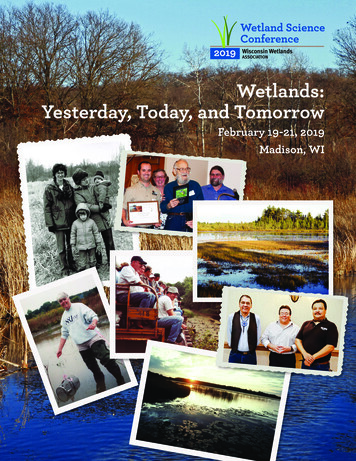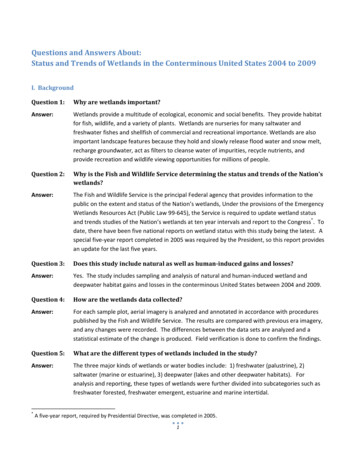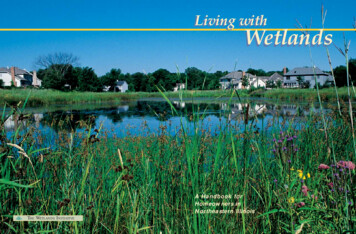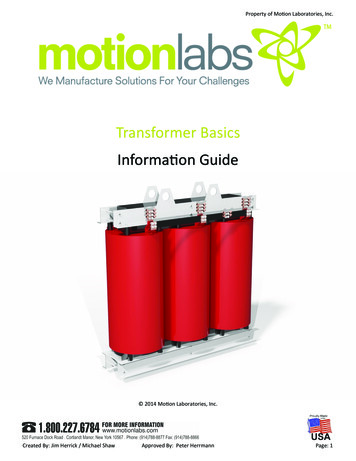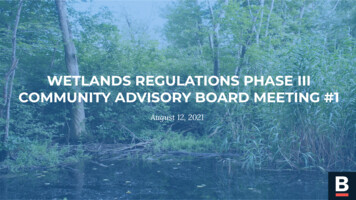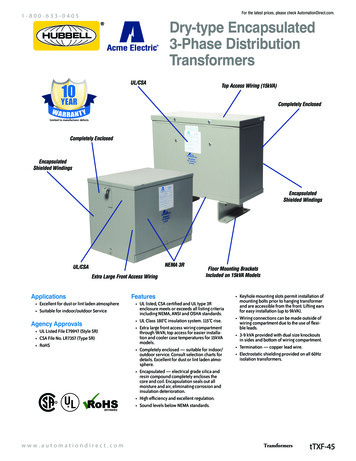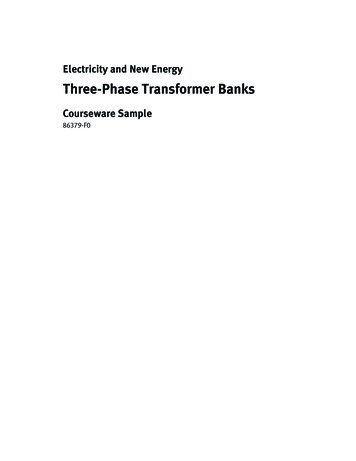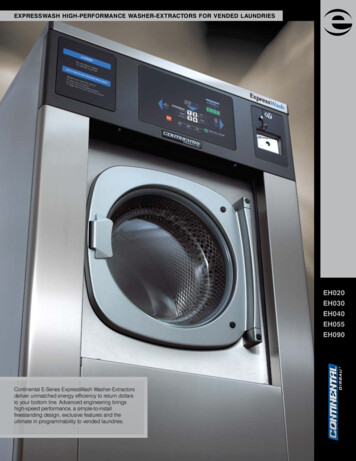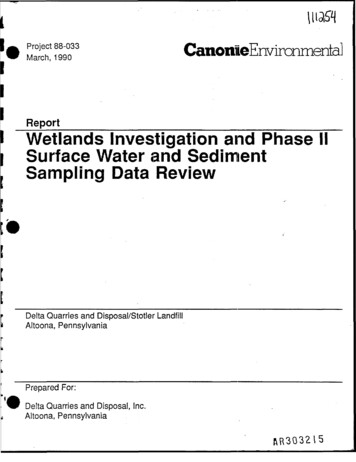
Transcription
IH3PICanonie' invircnmentalReportWetlands Investigation and Phase IISurface Water and SedimentSampling Data ReviewIfI'JIDelta Quarries and Disposal/Stotler LandfillAltoona, PennsylvaniaPrepared For:Delta Quarries and Disposal, Inc.Altoona, PennsylvaniaRR3G3215
CanonieECsrcr.is Envircr.rr-er'ai Sen-icss500 \ott 0-iph S;ad Sure 3.1March 7, 1990Phone2 .337- 55188-033-13-Ms, Donna McCartney (3HW12)United States Environmental Protection AgencyRegion III841 Chestnut BuildingPhiladelphia, PA 19107,TransmittalWetland Delineation Report and Phase II Reviewof Surface Water and Sediment Sampling DataDelta Quarries and Disposal/Stotler LandfillDear Ms. McCartney:Canonie Environmental Services Corp. is pleased to forward, for yourreview, four copies of the Wetland Delineation Report and Phase II Reviewof Surface Water and Sediment Sampling Data, for the Delta Quarries andDisposal/Stotler Landfill Site. Both reports were prepared by LancyEnvironmental Services Co. in fulfillment of the requirements of Task 16,Phases I and II, of the Site Remedial Investigation Work Plan.If you have any questions or comments, please feel free to call me.Very truly yours,Joseph E. Mihm, P.E.'reject SupervisorMLF/pmgcc; Carl Eyerett, Saul, Ewing, Remick and SaulJohn Niebauer, Delta Quarries and Disposal, Inc.AR3032'I6
P-. 2G-lmGOe!i4LflR3032!7
WETLAND DELINEATION REPORTfoeCanonic BwiranMental Services Corporation500 North Gulffc Bool - Suite 315King of Prussia, EA 1940616, 1989Prepared bylancy Environmental Services CdnparyDivision of lancy International, Inc.An Alcoa Separations Technology CcnpeuiyProject No. 21876flR3032i8
TOBLE OF OCN3BTCBPageIXST OF FIGURES.1IOST OF TABIES.11.0 WE&aUCZIW.22.0 METHODS AND 5WDCEDURES.33.0 RESUIZS AND DISCUSSION.53.1 Western Wetlands.3.2 Eastern Wetlands.584.0 LTTERATORE CTJ.il). 105.0 FIGORES. 116.0 TABTKS. 14AR3032I9
FigureWestern wetland and upland biotic ocraiunitiesand dominant vegetation types12Eastern wetland and upland biotic ocmounitiesand dominant vegetation types13T.TffT OF TABLESList of species, indicator status and lifeformsof vegetation found in the western wetland15Biotic comnunities and dominant vegetatican typesfound in the western wetland16Acreage and percent composition of wetland vsupland vegetation found in the western WEstland17Acreage and percent composition of vegetation typesfound in the western wetlandISList of species indicator status and lifeforms ofvegetation found in the eastern wetland19Biotic oninmities and dominant vegetation typesfound in the eastern wetland19flR303220
This report presents the results of a vegetation survey of two wetlardareas adjacent to- the Delta Qjarry landfill. The landfill is located abouttwo miles north of Altoona and one mile south of Pinecroft, PA.It isbounded by Sixth Avenue to the West and U.S. Route 220 to the East.wetlands surveyed encompass a total of 8.7 acres of which 8 acresare situated on the southwestern edge of the landfill and 0.7 acre issituated on the northeastern edge of the landfill.Ihe survey Included a determination of the transition lines betweenwetland and upland vegetation with emphasis on that portion of the wetlandsvegetation dominated by emergent aquatic vegetation. )A list of major dominant trees, shrubs, herbs and emergent, floatingand submerged aquatic vegetation is presented. Maps of both the western andeastern wetlands were developed based on the results of the field surveys.3ne report entitled "The Vegetation of Two Wetlands Showing Seepage From theDelta Altoona landfill, Pinecroft Pennsylvania" by Lloyd R. Stark, Ri.D. ,September, 1985 was used as the basis for this current delineation.AR30322
Hie initial field survey was conducted on Sepbenfcer 27 and 28, 1988. Asecond reconnaissance was conducted on August 17, 1989 to determine if anymajor changes had occurred in the wetland vegetation since the previoussurvey.Initially, a reconnaissance of the study site was conducted to observethe general topography and to establish suitable points of access. This wasfollowed by a cruise survey of the peripheries of the study areas.Transects were established along specific corpass headings. These transectswere established by close inspection of aerial photographs and enlargedcontour maps to insure that both the upland and lowland areas would beadequately surveyed and that variables in plant ccranunity conpcsition couldbe established.During the peripheral and transect cruise surveys, dominant species ofvarious forms of vegetation were observed. Notations were made of speciesccoposition and distribution on the enlarged contour maps and specimens ofthe various dominant plants were collected for species verification.Areas of qpen water were predetermined Jay close inspection of theaerial photographs. Wetland habitats were tentatively determined from thecontour maps and subsequently verified in the field.During the field survey, open water areas and other areas supporting apredoninance of emergent aquatic vegetation were more intensely studied.Ihe precise location and approximate size of the areas were determined inAR303222
the field and sketched on the contour maps.flowing water wsre noted.Areas of standing versusCollections of the various dominant energentaquatic plants were made for species verification*Relative abundance andccranunity cooposition were established.Color photographs were taken of both wetland areas during the initialfield survey in 1988 to assist in the evaluation.Specimens of vegetation collected were placed in plastic zip-lock bags,transported to the laboratory, and identified.From these specimens andidentifications made in the field, a checklist of the major plant speciesoccurring in both wetlands was compiled (Table 1 and Table 5).Hie contour maps were subsequently taped together to form one largemap. Colored felt-tipped markers were then used to delineate the uplands, mwetlands, biotic commities, and dominant vegetation types.From thesemaps and with the aid of the aerial photographs the accorpanying Figures 1and 2 were developed.In addition, the enlarged maps were used to determine the acreage andpercent composition of wetlands, uplands, and open water.Ihis wasaocccplished by using a grid having a scale of 1" « 50' fcfoere each sg. in. 3500 sg. ft. Acreage was then calculated using the conversion factor43,560 sq. ft. » 1 acre. Uiis data is contained in Table 3.Aquatic plants were verified using Fassett 1957. Associated vegetativeforms were verified using Gray 1950 and Britton and Brown 1970.ftR303223
3.0lagflJiaS AMD3.1The western wetland is large and sharply defined (Figure 1) . Exceptfor a narrw strip of inland area along its eastern edge adjacent to SixthAvenue, it is entirely surrounded by disturbed and altered acreage. Theseareas contain the facilities of the publicly owned treatiDent works for theCity of Altoona and a privately owned solid waste transfer station.The unaltered, undisturbed area conprises a total of 9.02 acres ofwhich 0.29 acres are open water, 7.71 acres; are supporting wetlandvegetation, and 1.02 acres are supporting upland vegetation (Table 3) .Deciduous trees compose 16.6% of the total mapped area, shrubs coipose 5.4%and forbs, grasses, emergent and floating vegetation ocrapose 78% of the area(Table 4) .The small percentage of shrubs and trees reflects the encroachment ofdeveloped areas having few fringe areas for their growth and support.Nine biotic cam-unities are represented in this area delineated (Figure1, Table 2) * Of these eight are wetland ccrarunities, the first three ofwhich are largely dominated by cut-grass , Leersia oryzoides ,Thedistinction between these three commities is subtle and dependent ongradient, water depth and species oonpetition for space. As indicated inTable 2, ccrarunity No. 1 is dominated solely by cut-grass, Leersia oryzoideswhicii becdtes invaded by cat-tail, Typha latifolia in No. 2 ccranunity.This in turn is additionally invaded by touch-me-not, Inpatiens capensis in
No. 3 nmmmity. Although there are a few other species occurring on theouter edge throughout these three coanunities, the/ occur sporadically as Bsubdoninants generally obscured by the dominant species. Ihus, about 80% ofthe total wetland area is dominated by the three species mentioned above.Biotic acraaunity No. 4 coMpnRed of a two species association, reedgrass, thraomites australis interspersed with cut-grass, laersia orvzoides.forms a dense stand immediately north of the entry of the west flow to thewetland. Flews from this source have, throu i time, carried with it siltand sand which has formed a slightly elevated delta upon which the reedgrass is thriving.The stand of reed grass almost bisects the wetland atthis point.Biotic u.iiiitmities Nbs. 5, 6 and 7 collectively contain the mostdiverse and complex vegetation associations within the entire wetland.Sixty-five percent of the wetland species were observed in these areas*Areas No. 6 and 7 constituted, large open-water areas supporting floating andemergent vegetation. Area No. 5 is a transition zone between the open waterareas terminating very abruptly against an upland area.Biotic calamityNo. 5 is heavily overhung by tree limbs growing on the upland areas.Consequently, area No. 5 is heavily shaded for a large part of the day.Biotic connunity No. 8 is transitory, This area is conposed of debrisand rubble deposited as fill and supports a biotic ccratunity of'facultative,facultative wetland and facultative upland vegetation.aR303225
The southern half of biotic ocncunity No. 9 is -trp-* of upland treeswhich diminish in the northern portion and give way to scrub-fcrush, shrubs,and imnature trees*This ccramnity is bordered throughout its length bySixth Avenue imnedlately to the east.Mast of the water supplying the wetland enanates fran the FAM springlocated at the southernmost point of biotic ocrrunity No. 9,Ohis issupplemented by runoff fran the west flow draining the wooded area on theeastern side of Sixth. Avenue which, during periods of heavy precipitationcontains leachate from the landfill. This flow enters the wetland near thesouthern edge of biotic ccmaunity No. 4.Hie entire wetland is completely saturated with water to an unknowndepth.Numerous attempts to wade across the wetland at various pointsproved to be impossible.In addition to deep water, in most placessediments were deep and when agitated, methane gas in considerable quantitywas released.This was especially apparent in the areas adjacent to thewaste water treatment plant lagoons.A stream, barely apparent at ground level, flows fran the prncte in thesouthern portion of the wetland, meanders through tiie aquatic vegetation andexits the wetland through a conduit at the northern corner. Flow continuesthrough a man-made ditch and enters the Little Juniata River downstream ofthe waste water treatanent plant effluent point.&R303226
description provided in the Stark (1985) report.Two erosion andsedimentation control structures with standpipes are now in place at thenortheastern corner of the landfill (Figure 2, Area 1).During the September 1988 evaluation, both of these basins were dry andfew aquatic plants were present.Ihe cnly dominant vegetation in bothbasins was cat-tail, Tvoha latifolia.Perennial ryegrass, lolium perennewas planted on surrounding slopes to stabilize soils and prevent erosion.Much of the ryegrass has encroachedinto the sedimentation basins.Goldenrod, Eu&iania cnraminifolia, is spcttily distributed on the outerfringe of some of the cat-tail areas.The area between the sedimentation basins and Sand Bank Road suppo:trees and shrubs. Ihe dominant trees are white oak, CXiercus alba, and sugarmaple, Acer saccharum (Figure 2, Area 2).A mixture of other species are scattered among them and includespcplar, Populus daltoides, sweet birch, Betula lenta, hawthorn, Crataequsk, apple, Pyrus SP and dogwood, Oornus foemina.At the time of field observations in September 1988, the depressionsbetween the higji wall of the sedimentation basins and the treed areas,(Figure 2, Area 3) were wet. Small areas of standing water were evident inboth locations and supported substantial growths of cat-tail with goldenrodoccurrying along the edges.8flR303227
Amcng the stand of trees between the two sedimentation basins, a numberof dead trees were noted. It was found that tliese dead trees were locatedjtttin standing water. This su rjests that the area was not originally a wetlandand only became one after the area was disturbed by landfill activity andthe construction of the sedimentation basins.tte capacity of the sedimentation basins are a natter of record. Oheacreage st jporting wetlazid vegetation in each of the basins is less than0.18 acres. Ihe wetland areas formed at the end of each of the standpipedrains range between 0.21 and 0.24 acres.The eastern wetlands are very small and lacking hi diversity in contrast tothe western wetland.The area has been recently disturbed and thevegetation is in a transitory stage of re-adapting to the alteredenvironment.flR303228
4,0 UHKA3UREBritten, Nathaniel L., and A. Brown. 1970. An Illustrated Flora of theUnited States and Canada. Dover Publications, Inc., New York.Fasaett, Norman C. 1957. A Jfenual of Aquatic Plants. , The University ofWisconsin Press. Madison, Wisconsin.Fernald, Merritt L, 1950. Grays Manual of Botany. American Book Co., NewYork.Stark, lacyd R. 1385. The vegetation of two wetlands absorbing seepage fromthe Delta Altoona landfill, Pinecroft, Pennsylvania. Consultants report toMeiser and Earl, Inc. , State College, Pennsylvania. 12 p.10SR303229
FTOTTPIgg11AR303230
fI URE ' and tofnantBR30323I
FIGURE 2. Eastern wetland and upland biotic communities and dominantvegetation types.
6.0 TABIES 14RR303233
2MEE.1List of species, iniioartion status and life foe* of vegetation fcurti in thewestern wetland*Scientific NameCtmnon NameAcer negundoAcer rubrumAcer saccharumCirsium vulgareOornus stolcniferaCrataegus sp.Bex Elder,Red MapleSugar MapleBull IhistleRed Osier DogwDOdHawthornFACKACEAOJI OJ:EACWf;FAOJ,IMicator SymbolLife ftarmTreeTreeTreeForbShrubTreeDipsacus sylvestrisTeasel;FAC ForbEchinochloa muricataEleacharis erythrcpodaWild MalletBald Spike Rush3RACWfQBLGrassGrasslikeEfilobium ooloratumWillcw-terbOBLForbEupatorium perfoliatumEuthania graminifoliaFagios grandifoliaInpatiens capensisLeersia oryzoidesLeama minorLycopus uniflorusNasturtium officinaleItaagmites australisBcaieset(SoldenrodAmerican BeechTcuch-roe-notRice WfForb3?%c EACWGrassIfcytolacca araericanaPokeweedBAOT-ForbPotanogeton sp.Prunus virginiana iercus albaSagittaria latifoliaScirpus cyperniusSolanum dulcamaraSynplocarpus foetidusTilia americanalypha latifoliaPondweedChokecherryOak, WhiteArrow-headVfcolgrassNightshadeSkunk cabbageBasswpodCat-tailOBLEACUEACUOBLFT TreeForbKey to Indicator SymbolsOBL - Obligate Wetland PlantsFACW - Facultative Wetland PlantsEAC - Facultative PlantsFAOJ - Facultative Upland PlantsUPL - Obligate Upland Plants15flR30323U
XffflH? aBiofrin coarunities and doninant vegetation types found in the western(ftxters refer to biotic coanmities as sbown in Figure 1) (Within comunities,plants are "Mflfrflrt in decreasing order of doninance) .1.leersia oryzoides, Cut-grass2,laersia oryzoides, Cut-grassTypha latifolia, Cat-tail3.lypha latifolia, Cat-taillaersia oryzoides, Cut-grassTnpatiens capensis, Touch-me-not4.Riragmites australis, Reed grassLaersia oryzoides, Cut-grass5.mpatians capensis, Otuch-me-notlaersia oryzoides, cut-grassTypfca latifolia, Cat-tailSolanum dulcamara, NightshadeSyrplocarpus foetidus, skunk cabbage6.Potamageton sp., PondweedLenna minor, DuckweedSagittaria latifolia, Arrow-head7.Nasturtium officinale, Vfeiter-cressLeama minor, DuckweedEpilcbium coloration, Willow-herbS.Dipsacus sylvestris, TeaselCiisium vulgare, Bull thistleInpatiens capensis, Touch-me-rxDtFhytolacca americana,9.Acer saccharum, Sugar mapleAcer rubrum, Red mapleQuercus alba, ftiite oakPrunus virginiana, QiokecherryFagus grandifolia, American BeechTilia americana, Basswxd16RR303235
Acreage and JWUMIL nrrfxv;itian of wetland vs. upland vegetation found in thewestern wetland BCCpen Water0.293.2W&tland Vegetation7.7185.5Upland Vegetation1.0211.39.02Acreage and percent ocnposition of vegetation types found in the western wetlandVeqetaticn TypeAcresTrees, Deciduous1.5Shrubs, Mixed0.4SForte, Grasses, Qnergents, Floating7.04Percent16.65.478.09.0217ftR303236
,List of SEiecJre?, indication status and life fbm of vegetation found in theeastern wetland.Scifintific NamefiaBEQJfemsIMicator SvntoolAcer rubrumRed *fepleFACTreeAcer saccharumSugar *fepleFAOJTreeAcer saccharinuraBetula lentaSilver IfepleSweet birchEACWFACUTreeShrubBetula nigraRiver birchFACWTreeOomus foeminaCrataegus sp.Euthania graminifoliaDcgwcod, raxinus sp.AshFACLslium perenneR egrassFAOJ-GrassItpulus deltoidesPcplarFACTreePrunus virginianaPyrus sp.Quercus albaViburnum dentatumOiokecherry pleOak, WhiteArrow wxdFAOJNiURLFACTree' TreeTreeShrubto Indicator StatusOBL - Obligate Wfetland PlantsFAC - Facultative Vfetlani PlantsFAC - Facultative PlantsFAOJ - Facultative UJpland PlantsUPL - Obligate Upland Plants18&R303237
Biotic ccmnities and dotinant vegetation types found in eastern wetland(Nunbers refer to biotic coaainities as shown in Figure 2) (Wit iin ccnnunities,plants are liBhnrf in decxeasing order of dcntinance) *1.2.lolium perene, perennial ryegrassfypha latifolia, cat-tailEuthania graminifoliaf goldenrod)Quercus alba, white oakAcer saocharumr sugar mapleErunus virginiana, choke cterryCornus foemina, stiff dogwood3.Typto latifolia, cat-tailEuthania graminifolia, goldenrod19AR303238
»d -nCO 333 -o oo rn 7 OOmm c oRR303239
PHASE IIREVIEW OFSURFACE MATER AND SEDIMENTSAMPLING DATAPrepared forCanonie Environmental Services Corporation500 North Gulph Road - Suite 315King of Prussia, PA 19406February, 1990Prepared byLancy Environmental Services CctnpanyDivision of lancy International, Inc.An Alcoa Separations Technology Company;Project No. 21876
1.0This report presents the results of a review and evaluation of surfacewater and sediment quality analyses of samples; collected frcci streams,wetlands and drainages in the vicinity of the Delta Quarry landfill locatedabout two miles north of Altoona, Pennsylvania.The purpose of this evaluation was to determine the potential impactsof the landfill on the suitability of the surface waters and sediments forthe maintenance of aquatic life.existingThe data obtained was compared withstate and federal ambient water quality criteriamaintenance of aquatic life.for theEvaluation focused on those chemicalparameters present in excess of the criteria. Since there are no state andfederal sediment quality criteria that have been established- for the supportof aquatic life, sediment data was evaluated by comparing with existing datareported in the scientific literature to the extent possible and practical.On August 4, 1988, a field reconnaissance of streamsf drainages, andwetlands was conducted in company with personnel frcm Meiser and Earl, Inc. ,State College, PA for the purpose of establishing sampling point locationsfor water, sediments, benthic macroinvertebrate organisms, and fishes.OnSeptember 26 and 27, 1988 benthic organisms were collected, preserved andretained for possible future processing and evaluation.During thissampling effort, observations were made of the habitat characteristics ateach location.Benthic organism samples are in the custody of lancyEnvironmental Services Company. The benthic organism samples were collectedcut of ptfiase since it was necessary to install weirs for flew measurementsRR3032U1
in several areas that would destroy the only suitable habitat available forbenthic organism collecting.On November 2, 3, and 4, 1988, personnel from Msiser and Earl, Inc.collected surface water and sediment samples for chemical analysis. Thesesamples were analyzed for the target conpound list (TCL) and, target analytelist (TAL)and for water quality parameters by the NUS Corporationlaboratory, Pittsburgh, PA. Analytical results are presented in Appeniix A.The water bodies sampled were the Little Juniata River, Sandy Run, alarge wetland located to the west of the landfill and adjacent to theAltoona wastewater treatment plant, a west flow drainage to the wetland andan east flow drainage to Sandy Run (Figure 1).The Little Juniata River originates within the environs of the City ofAltoona, flews in a northeasterly direction in an almost straight linechannel along the eastern side of the large Altoona railroad yards of theformer Pennsylvania Railroad, bends southeasterly near -the Blair-HuntingdonCounty line and joins with the Frankstcwn Branch near Alexandria, PA to formthe main branch Juniata River. The watershed extends over 343 square miles.Sandy Run originates near the northeast corner of the city of Altoona.It flows parallel to the Little Juniata River for a distance of 4.6 milesand joins it at the Borough of Pinecroft. The watershed is contained within8.64 square miles.&R3032U2
Additional sources of potential inpacts en surface waters in thevicinity of the landfill area include a POTW discharge, runoff fron urba fc )areas, a railroad yard, and three adjacent junk yards.flR3032U3
2.0 DISCD5SICN2.1 Field ObservationsDuring the process of sampling for benthic macroinvertabrates atvariaas locations, close observations were made of the appearance of thewater/ substrate, aquatic vegetation, aquatic and terrestrial life, and thepresence of pipes and conduits along the stream banks.West Flow and VfetlandsAt the time of benthic organism sampling, there was no flow occurringin the West Flow (SW8). There was some moisture in the soils at the originof the West Flow at the base of the landfill, however, at the point of entryinto the wetland, the soils were completely dry.The FAM Spring (SW7)was flowing steadily. In the immediate vicinityof the spring flow a population of crustacean, possibly amphipods commonlyfound in springs, was present in great abundance. The probability of manyother benthic organisms being present was sli #it due to the luckilyrestricted habitat.CXitflow from the wetland (SW4)inflow from the ERM Spring.outflow was very restricted.appeared to be about equivalent to thePhysical habitat in the stream formed by theHowever, during benthic sampling, severaltaxa of macroinvertebrates were observed. Habitat: in the area sampled wasaffected by soil erosion from road banks of the POIW sludge ponds.RR3032UH
The Little Juniata River was sanpled for benthic organisms atlocations (Figure 1).The upstream control (SW3) was located at a point inthe stream far enouc i away from the landfill that the probability of anyimpact ftom the landfill affecting that point in the stream would be nil.At the time of sampling it was observed that the stream bottom wassupporting numerous large patches of the filamentous algae Cladophora whichis well known to be a responder to nutrient substances. The Cladochora wasproviding habitat for a variety of benthic organisms, several of which areknown to occur in nutrient enriched waters. The substrate contained a highpercentage of cinder-like material blended with silt. A pipe along the left(west) shoreline was discharging a turbid flew from under the railroad yard.The origin of this discharge could not be determined.Sampling point SW15 was located immediately downstream of thedischarge point and upstream of the wetland discharge. The stream at thislocation was literally sterile except for a very sparse growth of a singlecelled algae. The stream bottom was scoured clean giving the rocks in thestream the appearance of having been scrubbed. With the exception of thealgae, there was a cccplete absence of any form of aquatic life. Evidenceof nutrient enrichment readily observed upstream at SW3 was gone.Thechange in ar earance was visibly abrupt and the affect from the POIWdischarge cculd be sharply delineated.The PCTW discharge was very clearand almost odorless.Sampling point SW2 was located immediately downstream of the wetlanddischarge. The stream at this point was showing a slight degree of recoveryfrom the effects of the POIW discharge. No apparent distinction could beAR3032U5
noted in the stream bctton upstream or downstream of the wetland discharge.Benthic organisms were not observed in this section of stream despite thepresence of very good physical habitat for their support. During sampling,a deer was seen crossing the stream in the vicinity of the POTW dischargeand a rauskrat was observed swisming along the shoreline upstream of thewetland discharge.Sampling point SW1 was located about 0.8 of a mile downstream from thewetland discharge at the village of Pinecroft upstream of the confluence ofSandy Run.A distinct septic odor was detected at this location. A slightmilky-gray cast was evident in the water color. OJhe source of these impactscould not be determined.Physical habitat for the support of benthicorganisms was good, however, macroinvertebrate organism diversity appearedto be poor. Ihere was an abnormally large number of leeches and bloodwormspresent in the samples collected at this location. This indicates that ahigh organic load and degraded water quality has persisted at this locationfor an extended period of time. During periods of high stream flows, localcitizens of Pinecroft have noted raw sewage in the stream in this section ofthe Little Juniata River as evidenced by paper and solids deposited alongthe river bank. This is possibly due to stonnwater bypass frcm the Altconawastewater treatment plant since there is no otiier waste-water treatmentplant upstream on the Little Juniata River.East Flew and Sandy RunSandy Run was sampled for benthic organisms at two locations.Theupstream control (SW13) was located at the end of Linwocd Road 0.9 mileupstream of the entry of the East Flew into Sandy Run. At this locationbenthic organism physical habitat was excellent and a very diverse andRR30321*6
abundant ccrarunity of aacrolnvertebrates was present, many taxa of whichwere those sensitive to poor water quality,Sanpling point SW14 on SanoV Run was located about 50 feet downstreamof the entry of the East Flow. At this location the physical habitat forbenthic macroinvertebrates was very good* Organism diversity and abundanceappeared to be very good. Ihere was no evidence of any inpact that mighthave resulted from poor water quality entering the stream from the EastFlow in the recent past.Olie East Flow at the time of benthic sampling was completely dry. Adistinct channel was observed through an overgrown pasture indicating pastflews.2.2 Evaluation of Surface Water QualityWest Flow and WetlandsIhe surface water quality analysis data for surface water samplesSW4, SW5, SW6, SW7 and SW8 were examined in relation to water qualitycriteria for the maintenance of aquatic life.Of these five samples,the only one which contained concentrations in excess of criteria wassanple SW8 from the West Flow. The chemical parameters that were foundto be in excess are iron, magnesium, manganese, silver, sodium, andanmonia. None of these chemical parameters, however, were found to bein excess of criteria in the FAM Spring nor in the samples taken withinthe wetland and at the outflow from the wetland. 31ie various chemicalparameters generally decrease in concentration as water flow passesthrough the wetland.RR3032U7
Metal-kudget and metal-flux data for wetland ecosystems show thatthe percentage of metal removed ty passage throu i the ecosystem varieswidely between metals and among wetlands (Giblin 1985), Wetland soilsgenerally serve as an initial sink for heavy metals such as cadmium,chromium, copper/ lead, mercury, nickel, and zinc (Richardson andNichols 1985).Metals dissolved in the soil solution or weaklyadsorbed to soil particles are readily available to the biota. Manystudies have shewn that heavy metals are taken up by freshwaterwetland plants through their roots and translocated to other parts ofthe plants.Various amounts of these metals; are then passed on toanimals feeding on live vegetation, litter, and detritus.Ammonia (N) was present in a high concentration (76 mg/1) in theWest Flow sample (SW8) and nitrate nitrogen concentrations were high(6.2,3.1 mg/1)in the wetland samples(SW6,SW5). However,concentrations of both ammonia and nitrate were greatly reduced in theoitflcw from the wetland (SW4). Obese parameters provide a source ofnutrient enrichment to the aquatic environment.Many wetlands have been shown to be nutrient traps that purify thewater flooding them. The principal nutrients are compounds of nitrogenand phosphorus.Ihe ability of wetlands to trap nutrients depends onthe age of the wetland, the magnitude of upland runoff, and wastewaterloading.From present understanding, wetlands appear to be netimporters of nitrogen and phosphorus during the spring.During latespring and summer, nutrients are tied up in plant bionass. After theaquatic plants die in the fall, a net export of nutrients takes placeassociated with the decomposition rate, (Mitsch and Gosselink 1986).8AR3032U8
Continuous input of high concentrations of nitrates and phosphate
areas contain the facilities of the publicly owned treatiDent works for the City of Altoona and a privately owned solid waste transfer station. The unaltered, undisturbed area conprises a total of 9.02 acres of which 0.29 acres are open water, 7.71 acres; are supporting wetland vegetation, and 1.02 acres are supporting upland vegetation (Table 3) .
